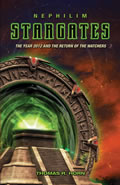PART 23
By Thomas R. Horn
December 3, 2010
NewsWithViews.com
WILL YOU G.R.I.N. FOR THE MARK OF THE BEAST?
Can
a microscopic tag be implanted in a person’s body to track his every
movement? There’s actual discussion about that. You will rule on
that—mark my words—before your tenure is over. —U.S.
Sen. Joseph Biden, asked during Senate Judiciary Committee  hearings
on the nomination of John Roberts to be chief justice of the Supreme Court
hearings
on the nomination of John Roberts to be chief justice of the Supreme Court
Although microchip implantation might be introduced as a voluntary procedure, in time, there will be pressure to make it mandatory. A national identification system via microchip implants could be achieved in two stages. Upon introduction as a voluntary system, the microchip implantation will appear to be palatable. After there is a familiarity with the procedure and a knowledge of its benefits, implantation would be mandatory. —Dr. Elaine M. Ramesh, patent attorney for Franklin Pierce Law Center
Now imagine a world in which every newborn baby immediately has a little capsule implanted under his armpit. Inside are monitors, tiny amounts of hormones, a wireless transmitter and receiver.... From birth, no moment in a person’s life will go unmonitored. —Joseph Farah, Whistleblower magazine
Unless you’ve been hidden under a rock for the past twenty years, you are probably familiar with the development of radio-frequency identification (rfid) technology that under certain applications is forecast to be connected to future Grin technologies, especially neurosciences, brain-machine interfacing, and cybernetics.
RFID chips employ tiny integrated circuits for storing and processing information using an antenna for receiving and transmitting the related data. This technology is most commonly applied as a “tag” for tracking inventory with radio waves at companies like Walmart, where consumer goods are embedded with “smart tags” that are read by hand-held scanners for supply chain management.
In recent years, rfid technology has been expanding within public and private firms as a method for verifying and tracking people as well. We first became aware of this trend a while back when chief of police Jack Schmidig of Bergen County, New Jersey, a member of the police force for more than thirty years, received a VeriChip (rfid chip) implant as part of Applied Digital Solution’s strategy of enlisting key regional leaders to accelerate adoption of its product.
Kevin H. McLaughlin, VeriChip Corp.’s chief executive officer at the time, said of the event that “high-profile regional leaders are accepting the VeriChip, representing an excellent example of our approach to gaining adoption of the technology” (note that VeriChip Corp. was renamed to PositiveID Corp. on November 10, 2009, through the merger of VeriChip Corp. and Steel Vault Corp.). Through a new and aggressive indoctrination program called “Thought and Opinion Leaders to Play Key Role in Adoption of VeriChip,” the company set out to create exponential adoption of its fda-cleared, human-implantable rfid tag. According to information released by the company, the implantable transceiver “sends and receives data and can be continuously tracked by gps (Global Positioning Satellite) technology.” The transceiver’s power supply and actuation system are unlike anything ever created. When implanted within a body, the device is powered electromechanically through the movement of muscles and can be activated either by the “wearer” or by the monitoring facility. In the wake of the terrorist attacks in New York and Washington, an information technology report highlighted the company’s additional plans to study implantable chips as a method of tracking terrorists. “We’ve changed our thinking since September 11 [2001],” a company spokesman said. “Now there’s more of a need to monitor evil activities.” As a result, PositiveID has been offering the company’s current incarnation of implantable rfid as “a tamper-proof means of identification for enhanced e-business security...tracking, locating lost or missing individuals, tracking the location of valuable property [this includes humans], and monitoring the medical conditions of at-risk patients.” While PositiveID offers testimony that safeguards have been implemented to ensure privacy in connection with its implantable microchips, some believe privacy is the last thing internal radio transmitters will protect—that in fact the plan to microchip humanity smacks of the biblical mark of the Beast. Has an end-times spirit indeed been pushing for adoption of this technology this generation?
Consider the following:
• According to some Bible scholars, a biblical generation is forty years. This is interesting, given what we documented in our book Apollyon Rising 2012 concerning the time frame 2012–2013, from which, counting backward forty years, one arrives at the year 1973, the very year Senior Scholastics began introducing school kids to the idea of buying and selling in the future using numbers inserted in their foreheads. In the September 20, 1973, feature “Who Is Watching You?” the secular high school journal speculated: All buying and selling in the program will be done by computer. No currency, no change, no checks. In the program, people would receive a number that had been assigned them tattooed in their wrist or forehead. The number is put on by laser beam and cannot be felt. The number in the body is not seen with the naked eye and is as permanent as your fingerprints. All items of consumer goods will be marked with a computer mark. The computer outlet in the store which picks up the number on the items at the checkstand will also pick up the number in the person’s body and automatically total the price and deduct the amount from the person’s “Special Drawing Rights” account.
• The following year, the 1974 article, “The Specter of Eugenics,” had Charles Frankel documenting Nobel Prize winner Linus Pauling’s suggestions that a mark be tattooed on the foot or forehead of every young person. Pauling envisioned a mark denoting genotype.
• In 1980, U.S. News and World Report revealed how the federal government was plotting “National Identity Cards” without which no one could work or conduct business.
• The Denver Post Sun followed up in 1981, claiming that chip implants would replace the identification cards. The June 21, 1981, story read in part, “The chip is placed in a needle which is affixed to a simple syringe containing an anti-bacterial solution. The needle is capped and ready to forever identify something—or somebody.”
• The May 7, 1996, Chicago Tribune questioned the technology, wondering aloud if we would be able to trust “Big Brother under our skin?”
• Then, in 1997, applications for patents of subcutaneous implant devices for “a person or an animal” were filed.
• In August 1998, the bbc covered the first-known human microchip implantation.
• That same month, the Sunday Portland Oregonian warned that proposed medical identifiers might erode privacy rights by tracking individuals through alphanumeric health identifier technologies. The startling Oregonian feature depicted humans with bar codes in their foreheads.
• Millions of Today Show viewers then watched in 2002 when an American family got “chipped” with Applied Digital Solution’s VeriChip live from a doctor’s office in Boca Raton, Florida.
• In November of the same year, ibm’s patent application for “identification and tracking of persons using rfid-tagged items” was recorded.
• Three years later, former secretary of the Health and Human Services department, Tommy Thompson, forged a lucrative partnership with VeriChip Corp. and began encouraging Americans “to get chipped” so that their medical records would be “inside them” in case of emergencies.
• The state of Wisconsin—where Thompson was governor before coming to Washington—promptly drew a line in the sand, passing a law prohibiting employers from mandating that their employees get “chipped.” Other states since have passed or are considering similar legislation.
• Despite this, in the last decade, an expanding number of companies and government agencies have started requiring the use of rfid for people identification. Unity Infraprojects, for example, one of the largest civil contractors in India, tracks its employees with rfid, as does the U.S. Department of Homeland Security for workers involved in baggage handling at airports.
• Since September 11, 2001, the U.S. government has proposed several versions of a national id card that would use rfid technology.
• Starting in 2006, the U.S. government began requiring passports to include rfid chips.
• Hundreds of Alzheimer’s patients have been injected with implantable versions of rfid tags in recent years.
• RFID bracelets are now being placed on newborns at a growing list of hospitals.
• Students are being required in some schools and universities to use biometric id employing rfid for electronic monitoring.
• Thousands of celebrities and government officials around the world have had rfid radio chips implanted in them so that they can be identified—either for entry at secure sites or for identification if they are kidnapped or killed.
• Others, like Prof. Kevin Warwick (discussed earlier), have been microchipped for purposes of controlling keypads and external devices with the wave of a hand.
• Besides providing internal storage for individual-specific information like health records, banking and industry envisions a cashless society in the near future where all buying and selling could transpire using a version of the subdermal chips and wireless authentication. As mentioned above, in 1973, Senior Scholastics magazine introduced school-age children to the concept of buying and selling using numbers inserted in their forehead. But more recently, Time magazine, in its feature story, “The Big Bank Theory and What It Says about the Future of Money,” recognized how this type of banking and currency exchange would not require a laser tattoo. Rather, the writer said, “Your daughter can store the money any way she wants—on her laptop, on a debit card, even (in the not-too-distant future) on a chip implanted under her skin.”[1]
• In 2007, PositiveID, which owns the Food and Drug Administration-approved VeriChip that electronically transmits patients’ health information whenever a scanner is passed over the body, ominously launched “Xmark” as its corporate identity for implantable healthcare products.
• And now, at the time this book is going to the printer, the Department of Homeland Security is working out how to implement the “Real id Act,” with the goal of codifying an international biometric id system.
The list above continues to accumulate, causing a growing number to wonder if rfid adoption will, for all practical purposes, result in every man, woman, boy, and girl in the developed world having an id chip inside them (like animals worldwide already do) sometime this century. Students of eschatology (the study of end-times events) find it increasingly difficult to dismiss how this all looks and feels like movement toward fulfilling Revelation 13:16–17: “And he causeth all, both small and great, rich and poor, free and bond, to receive a mark in their right hand, or in their foreheads: And that no man might buy or sell, save he that had the mark, or the name of the beast, or the number of his name.”
As newer versions of rfid-like transmitters become even more sophisticated—adding other “prophetic” components such as merging human biological matter with transistors to create living, implantable machines—the authors of this book believe the possibility that the mark of the Beast could arrive through a version of this technology increases. That is one reason we found the recent Discovery News report, “Part-Human, Part Machine Transistor Devised,” particularly disturbing:
Man and machine can now be linked more intimately than ever. Scientists have embedded a nano-sized transistor inside a cell-like membrane and powered it using the cell’s own fuel. The research could lead to new types of man-machine interactions where embedded devices could relay information about the inner workings of proteins inside the cell membrane, and eventually lead to new ways to read, and even influence, brain or nerve cells.
“This device is as close to the seamless marriage of biological and electronic structures as anything else that people did before,” said Aleksandr Noy, a scientist at the University of California, Merced, who is a co-author on the recent ACS Nano Letters. “We can take proteins, real biological machines, and make them part of a working microelectronic circuit.”[2]
| Subscribe to the NewsWithViews Daily News Alerts! |
A similar story (“Dna Logic Gates Herald Injectable Computers”) was published by New Scientist magazine the same month as the story above, and a few weeks earlier, an article by the Daily Mail (“Meet the Nano-Spiders: The dna Robots that Could One Day Be Walking through Your Body”) reported the creation by scientists of microscopic robots made of dna molecules that can walk, turn, and even create tiny products of their own on a nano-scale assembly line. This is important because a while back, a secret was entered into our new book Forbidden Gates that we could not have even imagined in the recent past..
[Editor's note: This series is based on research contained in Tom and Nita Horn's new book: Forbidden Gates: How Genetics, Robotics, Artificial Intelligence, Synthetic Biology, Nanotechnology, & Human Enhancement Herald the Dawn of Techno-Dimensional Spiritual Warfare. Learn more here]
Click here for part -----> 1, 2, 3, 4, 5, 6, 7, 8, 9, 10, 11, 12, 13, 14, 15, 16, 17, 18, 19, 20, 21, 22, 23,
Footnotes:
1,
Joshua Ramo, “The
Big Bank Theory,” Time (4/27/98)
2-
Eric Bland, “Part-Human,
Part-Machine Transistor Devised,” Discovery News (6/2/10),
emphasis added
� 2010 Thomas Horn - All Rights Reserved
Sign
Up For Free E-Mail Alerts
E-Mails are used strictly for
NWVs alerts, not for sale
Thomas Horn is the CEO of RaidersNewsUpdate.com and SurvivorMall.com.
Over the last decade, he has authored three books, wrote dozens of published editorials, and had several feature magazine articles. In addition to past articles at NewsWithViews.com , his works have been referred to by writers of the LA Times Syndicate, MSNBC, Christianity Today, Coast to Coast, World Net Daily, White House Correspondents and dozens of newsmagazines and press agencies around the globe. Tom's latest book is "The Ahriman Gate," which fictionalizes the use of biotechnology to resurrect Biblical Nephilim.
Thomas is also a well known radio personality who has guest-hosted and appeared on dozens of radio and television shows over the last 30 years, including "The 700 Club" and "Coast to Coast AM." When looking for a spokesperson to promote their film "Deceived" staring Louis Gossett Jr. and Judd Nelson, "Cloud 10 Pictures" selected Thomas as their spokesperson to explain the Christian viewpoint on UFO-related demonology.
Web Site: RaidersNewsUpdate.com
E-Mail: RaidersNewsUpdate@gmail.com













 Share
This Article
Share
This Article








